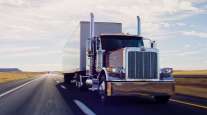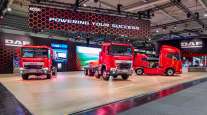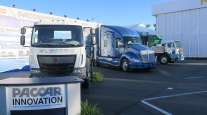Managing Editor, Features and Multimedia
Paccar CEO Outlines Path Toward Zero-Emission Trucks, Automated Driving

SAN FRANCISCO — Paccar Inc. CEO Ron Armstrong said the trucking industry is moving toward ever-cleaner and more energy-efficient vehicles and will adopt increasingly advanced automated driving technology to assist drivers.
“The future of the industry is very dynamic, with technology accelerating the pace of change,” Armstrong told an audience of truck dealers from across the country during remarks here Jan. 25 at the 2019 American Truck Dealers Show. “Now more than ever, we need to innovate to stay relevant.”
ALSO AT ATD: ATD Announces Coalition to Repeal Federal Excise Tax on Heavy-Duty Trucks
Paccar is the parent of Kenworth Truck Co., Peterbilt Motors Co. and international brand DAF Trucks.
Federal Phase 2 greenhouse-gas emission standards will result in the introduction of more aerodynamic trucks and new engine technologies to meet regulatory requirements, Armstrong said.
He also predicted that fleet consolidation will continue as carriers seek to improve equipment utilization and overall efficiency. That trend will boost adoption of connected-vehicle services, as well as advanced driver-assistance systems to increase safety and efficiency while reducing fleets’ dependence on highly skilled drivers, he added.

Kenworth and Toyota showcased a hydrogen-electric tractor based on Kenworth's T680 model and branded with both companies’ names at CES in Las Vegas this month. (Seth Clevenger/Transport Topics)
Over the next five years, truck manufacturers and fleets will increase field testing and low-volume production of electric-, hydrogen- and hybrid-powered trucks to determine the best applications for those vehicles, Armstrong said.
He highlighted Peterbilt’s lineup of battery-electric prototype models, Kenworth’s tests of hydrogen-electric trucks and DAF’s hybrid and electric trucks for the European market.
Armstrong said there could be an important place for diesel-electric hybrids in the commercial vehicle market by 2024, when the second stage of the Phase 2 GHG requirements goes into effect.
“A parallel hybrid solution could be an effective technology to reduce fuel usage and CO2 output in most, if not all, of our powertrains,” he said.
Over time, as the weight and cost of fuel cell and battery-electric powertrains improve, those vehicle technologies “could become preferred methods to achieve zero emissions in the future,” Armstrong said. “Fuel cells could enable a heavy-duty truck to have a range similar to diesel, and battery-electric vehicles could meet the needs of regional haul and medium-duty customers.”
In the near future, Paccar plans to introduce next-generation driver assistance features, including steering assistance, enhanced active braking and traffic jam cruise control at low speeds.
Those capabilities would build upon active safety systems that already are available, such as collision mitigation, lane departure warnings and blind spot monitoring.

Peterbilt’s autonomous development tractor at the Paccar Innovation Center. (Paccar)
The truck maker also is investigating autonomous driving technologies such as auto docking, which could automatically maneuver a tractor trailer into a loading dock.
Beyond that, Armstrong said Paccar is developing trucks with driver-assist technology that would offer SAE Level 4 automated driving capabilities, in which the driver can completely disengage and let the system take control under certain conditions.
“These vehicles will make operating decisions with inputs from cameras, lidar and radar,” he said. “We’re working ultimately toward having Level 4 ADAS vehicles ready in the next few years.”
Another area of interest is expanding connected vehicle services and utilizing vehicle and operational data to offer new products and support fleet customers.
Some of the truck maker’s development work on emerging technologies is taking place at the Paccar Innovation Center in Silicon Valley, which opened in September 2017.
“The facility has increased the speed of interaction with technology companies and increased our access to new opportunities,” Armstrong said. “Many startups are interested in mobility and are excited to work with us.”




